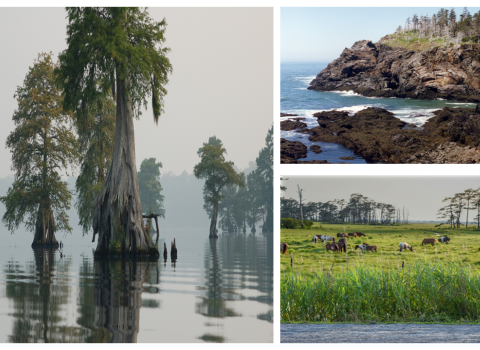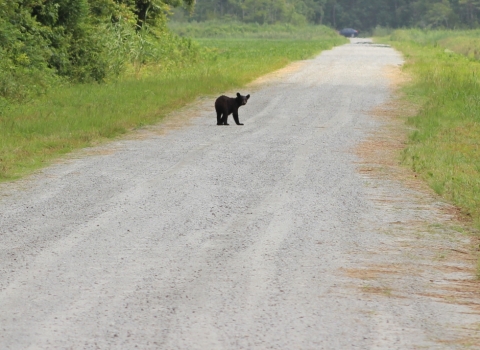On Thursday, March 1, 2007 the U.S. Fish and Wildlife Service will hold a joint Public Hearing in Anchorage to present information and take public comments on the 12-month petition finding and proposed rule to list the polar bear as ?threatened? throughout its range under the Endangered Species Act. The meeting will be held at the Loussac Library's Wilda Marston Theatre from 7:00 to 10:00 pm. The Service will also accept written, hand delivered or emailed comments until close of business April 9, 2007. Details can be found at: http://alaska.fws.gov/fisheries/mmm/polarbear/issues.htm.
The meeting will begin with a presentation by U.S. Fish and Wildlife Service and the U.S. Geological Survey providing background on the petition finding and proposed rule and the process ahead. The purpose of this portion of the evening is to provide opportunities for the public to obtain information about, and ask questions concerning, the proposal in order to assist the public in preparing comments. It is anticipated that this public information segment of the meeting will run from approximately 7:00 to 8:00 pm.
Immediately following the presentation and question and answer session, the public hearing will be held from 8:00 to 10:00 pm. These public hearings will be the only opportunities for comments and data to be presented verbally for entry into the public record and for consideration prior to the final decision on the proposed rule. Anyone wishing to make an oral comment or statement will be asked to register upon arrival at the meeting. Those wishing to provide oral comments at the meeting are encouraged to also provide a written copy of their statement to the Service at the hearing, though this is not required, and oral and written comments will receive equal consideration.
If you wish to provide comments or data but do not wish to speak, written comments will be accepted at the meeting, or can be sent in writing or electronically until close of business (5 pm) Alaska Local Time on April 9, 2007. Comments can be submitted by mail to:Supervisor, U.S. Fish & Wildlife Service, Marine Mammals Management Office, 1011 East Tudor Road, Anchorage, AK 99503; by email to: Polar_Bear_Finding@fws.gov; or through the federal rulemaking portal at http://www.regulations.gov/fdmspublic/component/main. The Service is particularly interested in comments concerning:
RE MARGIN-LEFT: 1in 4. 4 5. 387. 5(1) Information on taxonomy, distribution, habitat selection (especially denning habitat), food habits, population density and trends, habitat trends, and effects of management on polar bears;
RE MARGIN-LEFT: 1in 4. 4 5. 387. 5(2) Information on the effects of sea ice change on the distribution and abundance of polar bears and their principal prey over the short and long term;
RE MARGIN-LEFT: 1in 4. 4 5. 387. 5(3) Information on the effects of other potential listing factors, including oil and gas development, contaminants, ecotourism, hunting, poaching, on the distribution and abundance of polar bears and their principal prey over the short and long term;
RE MARGIN-LEFT: 1in 4. 4 5. 387. 5(4) Information on regulatory mechanisms and management programs
RE MARGIN-LEFT: 1in 4. 4 5. 387. 5 for polar bear conservation, including mitigation measures related to oil and gas exploration and development, hunting conservation programs, anti-poaching programs, and any other private, tribal, or governmental conservation programs which benefit polar bears;
RE MARGIN-LEFT: 1in 4. 4 5. 387. 5(5) The specific physical and biological features to consider, and specific areas that may meet the definition of critical habitat and that should or should not be considered for a proposed critical habitat designation as provided by section 4 of the Endangered Species Act;
RE MARGIN-LEFT: 1in 4. 4 5. 387. 5(6) Information relevant to whether any populations of the species may qualify as distinct population segments; and
387.(7) The data and studies referred to within the proposal.
The U.S. Fish and Wildlife Service is the principal federal agency responsible for conserving, protecting, and enhancing fish, wildlife, and plants and their habitats for the continuing benefit of the American people. The Service manages the 95-million-acre National Wildlife Refuge System, which encompasses 542 national wildlife refuges, thousands of small wetlands and other special management areas. It also operates 69 national fish hatcheries, 64 fishery resource offices, and 81 ecological services field stations. The agency enforces federal wildlife laws, administers the Endangered Species Act, manages migratory bird populations, restores nationally significant fisheries, conserves and restores wildlife habitat such as wetlands, and helps foreign governments with their conservation efforts. It also oversees the Federal Aid program that distributes hundreds of millions of dollars in excise taxes on fishing and hunting equipment to state fish and wildlife agencies.
center 3.65inFor more information about the U.S. Fish and Wildlife Service, visit our home page at http://www.fws.gov">"


